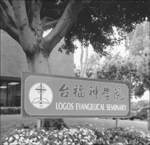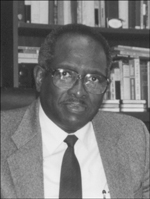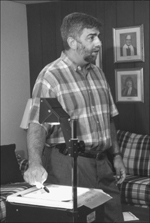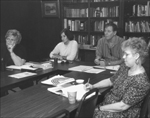If there were such a thing as a typical member of the Association of Theological Schools in the United States and Canada, Logos Evangelical Seminary in El Monte, California, would not be it. The school was founded just ten years ago as a seminary of the Evangelical Formosan Church, a denomination begun in California in 1970. Instruction is offered in Mandarin and Taiwanese (the first English course is scheduled for this fall). The student body is entirely Asian (albeit remarkably pan-Asian, coming from homes as far-flung as Paris and Jakarta). One in four of the seminary’s graduates works in Taiwan. The campus used to be an office complex and, in fact, unused space is still rented to the state of California.
Nevertheless, Logos has just successfully completed the ATS accreditation process, and the story of its journey toward that goal is hardly foreign. Logos officials’ comments on the process run parallel with those of other newly accredited schools (like Hood Theological Seminary in Salisbury, North Carolina) and those reaccredited under the ATS’s new standards (including Phillips Theological Seminary in Tulsa, Oklahoma).
 |
| Logos Evangelical Seminary’s new campus in El Monte, California, is assessed at $4 million.
Photograph by
Juju Huang
|
First Steps
“We didn’t think of accreditation right away,” said Silas Chan, the vice president of academic affairs, “and we haven’t thought of it as a goal so much as a step as we reach for excellence to serve the Lord. People in the U.S. see accreditation as a basic standard of a school’s quality.”
A year after Logos began, the school was authorized by California’s Council for Private Postsecondary and Vocational Education to confer degrees. This approval also allowed Logos’s international students to apply for student visas. At first, denominational members thought that approval was enough. “Asians are used to government-sponsored education and not to outside accrediting agencies,” said Chan. Perhaps they were also daunted at the prospect of more paperwork. “The CPPVE is very picky about details of compliance. It seems they want to pick out something wrong so they can give you some paper,” deadpanned Chan.
The school has a carefully crafted board, though, replete with educators who were quick to see and to point out the relevance of ATS accreditation to the school’s mission, notwithstanding the paperwork. They realized that ATS accreditation standards could be used as leverage in moving the school toward excellence: the librarian, the dean of students, the accountant at Logos can each point to improvements in their departments and say, “Who knows when or whether we would have done this if we didn’t need to for accreditation?”
When Daniel Aleshire, then ATS associate director for accreditation and now ATS executive director, first visited Logos’s rented campus in 1994, he found a school not quite ready for prime time. Chan leaned back and winced through laughter as he recalled the day: “I think he smelled our situation,” he said. Aleshire left them three immediate objectives: develop a standard accounting system (“In Taiwan,” said Isaac Chen, professor of systematic theology, “your face is your credit”), put together a library, and either get land of your own or have $3 million in reserve. Two years later, when Aleshire returned, he found the school situated on a $2.3 million campus (since reassessed at more than $4 million) in a Los Angeles suburb, a growing library linked into the Southern California Association of Theological Libraries, and a newly hired accountant working to standardize accounting practices. The school, by then an associate member of the ATS, was ready to begin the self-study process.
The Self-Study Structure
The school quickly put together a tightly organized self-study structure with three chairs reporting to Silas Chan, the coordinator. “We mobilized everybody in every sector to prepare,” Chan said. Each, in turn, had subcommittees involving members of the faculty, board, student body, and staff, all of whom were connected by an elaborate system of internal memos noting progress made.
The study itself took many forms. There was an actual physical count of volumes in the library, carried out by volunteers from women’s groups in local churches, and an hourly headcount of students using the library. (This work led to the formal acquisitions policy and to a collection development policy, which librarian Shieu-Yu Hwang thinks might not have happened without the study.) There were telephone interviews with the school’s graduates and questionnaires for current students about the strengths and weaknesses of their preparation.
That the school’s books, formerly done in utterly idiosyncratic fashion, had been brought into line with general accounting principles by accountant Jenny Liu was corroborated by the seminary’s first external audit. (Board member Andrew Huang, senior auditor for the city of Los Angeles, had much to do with the achievement of this goal.)
The board had a special set of challenges as they worked with the standards on governance: they were faced with a style of governance that was not intuitive for them. Isaac Chen, who chaired the governance section of the self-study, talked of the challenge of instituting board structures when the group came from an approach best described as, “We need this, we need that. I’ll do this, you do that. The Western leadership, on the other hand, seems more bylaw-oriented than human-oriented.” The study has turned the board toward its next challenge, that of sorting out the school’s relationship with the denomination’s general assembly, which is still not entirely comfortable with the necessity of codifying the nature of the channels of authority.
Visit and Decision
The self-study committee was formed in December 1997. Eleven months later, the information it collected had been codified, refined, and put into final form. The self-study was sent to the ATS in November 1998. In April, the visitation team arrived, composed of three representatives of accredited schools (visitors are chosen to bring both a diversity of experience and some points of commonality with the school being visited) and Katherine Amos, ATS director of accreditation. In its report, the team thanked the school for those at the school who “sensitively attuned generous and thoughtful Taiwanese hospitality to our North American tastes and needs.” The school, in turn, appreciated the style of the team, which New Testament professor Julie Lee Wu described as “very candid, and at the same time very encouraging.” There were moments of bonding around small surprises, too, as when the team saw that Logos has found a use for the old card catalogue cases that stand empty in libraries now that the catalogue has been computerized. Audio cassettes fit perfectly into the drawers!
Logos Evangelical Seminary received ATS accreditation in June. The visiting team’s report raised concerns that surprised no one—the school’s relationship with its parent denomination and the faculty workload. At the same time, it affirmed the school’s understanding of and fidelity to its mission—even as that mission evolves from preparing ministers for the Taiwanese church to include, first, other Chinese-speaking people, and now, second-generation Chinese-Americans. It is the school’s commitment to its mission that led it into the self-study and through it with such energy. When students and faculty enter chapel each day, they are greeted by massive Chinese characters that exhort (in translation): “Achieve great things. Rescue millions of souls.” This motto came from Logos’s president, Felix Liu, a quiet man who has put together a team committed to the same mission and let it take its course. It plays out in a sense of community at the school when nearby churches fix lunch for the community once a month, when faculty and staff gather weekly to pray for the school and those connected with it, when students and faculty meet at their plots in the small garden behind the library.
 |
| Albert Aymer has been dean of Hood Theological Seminary since 1995. |
Hood’s Long Journey
Logos Theological Seminary was accredited ten years after its inception: Hood Theological Seminary in Salisbury, North Carolina, was 116 when it was accredited by the ATS last year. Hood, a school of the African Methodist Episcopal Zion Church—which predates the ATS by fifty-six years—was invited earlier to become one of the association’s members. Hood’s leaders declined, according to dean Albert Aymer, because of a strong sense that “‘This is our school.’ The church was skeptical of a non-African-American agency telling it what do. And we had a different breed of bishops then, who felt the need to control the school.” Things changed over the years, both for the ATS and the school. Aymer cites the civil rights and ecumenical movements as major influences on both parties. By the early 1980s, the school was willing to take a look at ATS membership but, according to Aymer, “just wasn’t able to meet the standards.” He was hired in 1995, when the school was ready to try again. (The school’s accreditation followed that of Payne Theological Seminary, a historically black school in Wilberforce, Ohio, by three years. This lends credence to the expectation of various people at Logos that other Asian-American seminaries—and there are ten in California alone—will now pursue ATS membership. Similar spates of growth have occurred in ATS before. A flood of Roman Catholic schools, for example, joined in the late 1960s and early 1970s.)
“I don’t know why people think the accreditation process is something to be dreaded,” said Aymer, as he paid tribute to the ATS staff and celebrated the way the school’s board and staff handled the job.
Aymer’s first task, he recalled, was to help the board understand the value of accreditation for Hood. “I talked about the integrity of our degrees, about possibilities for foundation funding, about what could happen in terms of student population. They were disposed to hear this,” he said, “and willing to add faculty, to add funding. They were very gracious.”
Several areas of the school’s life required immediate attention. Aymer describes the curriculum he inherited as “idiosyncratic from years of doing our own thing. The faculty reworked curriculum with attention to those in place at Drew (where Aymer had been associate dean), Duke, and Yale. “Next came the delivery system,” said Aymer. The faculty grew from four to six full-time members, and the library was put into the hands of “a librarian God sent us. We gave her carte blanche. First she weeded like crazy, then we put out the word that we were accepting libraries from retiring pastors and academics.”
A parallel development of the school’s place in its community happened at the same time. “When I got here,” said Aymer, “and went to the hardware store, I’d tell them that I was the new dean at Hood. They’d look at me—and then some got brave enough to ask, ‘Where?’ We have signs up now, but more than that, the school is seeking to become a catalyst for the community. Last year someone from the large—and largely Caucasian—United Methodist church in town funded a dinner we hosted for 300 church people from the community. And it wasn’t just a fund-raiser. It was an opportunity for folks from the white and black churches to sit across the table and talk.”
Curriculum, faculty, and library resources are thoroughly addressed in the ATS standards. Community goodwill, obviously, is not. But for Hood, the two are intimately bound up together. And the changes have led to increased enrollment—the head count has gone from thirty to more than a hundred students in five years. The school’s next step is likely to be campus expansion. Aymer summarizes his approach to growth—to the accreditation process, all it has brought, and all to which it might lead—by saying, “Without sounding terribly pious, I believe that God doesn’t call anybody to do anything without preparing the way.”
 |
| Adjunct instructor Ray Hickman teaching a class at Phillips in conflict management.
Photograph by
Mel Root
|
Phillips Resettles
Phillips Theological Seminary, founded in 1907, was first accredited in 1952 and has been reaccredited at regular intervals ever since. The most recent reaccreditation visit came earlier than it would have under ordinary circumstances, however, because recent circumstances at Phillips have been out of the ordinary. When the city of Enid, Oklahoma, bought the campus of Phillips University, an early spinoff of the seminary with which the seminary was still affiliated in the 1980s, church-state issues came to the fore, and the seminary was forced to separate from the university. (The university has since gone bankrupt, causing no end of consternation for the seminary as it attempts to convince its vendors that it is still paying its bills.) The seminary had to grow a new board—the old seminary board was an advisory council to the university and met just once a year. Along the way, the seminary decided to move to Tulsa. Plans are afoot to build a new campus, but in the meantime the school exists in several places, including mauve-and-powder-gray third-floor office space in a building three miles from downtown Tulsa; a couple of University of Tulsa-owned houses slated for demolition; and regular library and classroom facilities leased from the university. And, to cap it all, until this year the school existed on both the Enid and Tulsa campuses.
What is left to define the school? Not props, certainly—as president William Tabbernee put it: “We couldn’t very well carry away the stained glass from a chapel that wasn’t our property.” The mission of the school is its identity, and it still identifies itself as “the only source of mainstream theological education between Denver, Dallas, and Kansas City.”
Phillip’s latest self-study, then, was an opportunity to see how the school had come through the transition and, in the words of dean Gary Peluso, to ask, “Are we offering the education we claim to be offering? How can we tell?”
The Board Comes Aboard
Reaccreditation was also an opportunity for new board members to gain a great deal of insight into their institution quickly. “None of it was easy,” said board chair Ruth Ann Fate. “Self-examination never is. Some of it was painful—but it was marvelous.” The board connected to the process at four main points:
-
In spring 1998, the board heard and responded to a presentation by Peluso on ATS accreditation standard number eight, the section on governance. “It was an exegesis,” he said, “and a word study of the recurring word ‘trust.’”
-
In autumn 1998, the board and faculty met together in retreat at a state park. This was the first time the board had met in retreat. “We learned about expertise we didn’t know we had,” said Fate. New Testament professor Brandon Scott said, “It gave the board more of a sense of all that it takes to run the school, of our professional lives outside the classroom.”
-
Board member William Inglish, a pastor in Stillwater, Oklahoma, sat on the self-study steering committee throughout the process, providing a consistent link to the trustees.
-
The whole board received the final version of the self-study for comment. Did they read it? “It was long,” said Peluso. (It was, in fact, 120 single-spaced pages.) “But those who did read it recognized the institution, and were grateful to the staff for their time and energy in preparing it.”
 |
| Students (from left) Fran Callaway, Cynthia Graham, Richard Newman, and Roberta Shaffer in Hickman’s class, which he titled “Issues in Practical Theology from Cain and Abel to Clinton and Starr.”.
Photograph by
Mel Root
|
Scott is a veteran of a number of self-studies at several schools, both as a faculty member and as a visiting team member. His appreciation for Phillips’s most recent self-study has to do with the change in ATS accreditation standards in 1996. “The old standards were much more a matter of jumping through hoops. To some extent we were playing a game. Now we’re looking to our own self-understanding and basing our assessment there. It’s more possible to set our own trajectory.” His major complaint about the process is the burden it places on small schools, whose self-studies are almost as big as those of larger schools.
Scott also noted that the study was not entirely free of hoops to be jumped, provided by the North Central Association of Colleges and Schools. In common with about 80 percent of ATS schools, Phillips is also accredited by a regional accreditor. (There are six regionals: besides North Central, the list includes the Southern Association of Colleges and Schools, the Middle States Association of Colleges and Schools, the New England Association of Schools and Colleges, the Northwest Association of Schools and Colleges, and the Western Association of Schools and Colleges.) Once a school has been initially accredited by both agencies, they can do the same self-study for both, and be visited by teams from both agencies simultaneously, although the standards of the agencies are not identical and the agencies’ actions are independent of one another. Regional agencies’ standards tend to have more to do with required numbers—of volumes in the library, of faculty, of bottom lines—than those of the ATS. The self-study team at Phillips decided to write its report for the ATS, making sure to include the information NCACS needed.
Life Outside the ATS
Dual accreditation is not a necessity. Hood was SACS-accredited for many years before it became involved with the ATS. Logos doesn’t think that WASC accreditation is especially relevant for it now. And in Canada there is no such thing, properly speaking, as dual accreditation. The regulation of schools varies from province to province, and between university-related and freestanding schools, which are less regulated. University-related schools are closely regulated by the Ministry of Colleges and Universities and subject to mandated internal assessment and monitoring. Principal William Brackney of McMaster Divinity College, a Baptist school in Hamilton, Ontario, describes the former as “more irritating than anything a regional could throw at you every five years.” In Ontario, the province accredits schools; in most other places, it does not, and theological schools in British Columbia are united in their opposition to provincial plans to start accrediting them.
ATS accreditation may not be appropriate to every theological school. Some that have been in the process have removed themselves. Liberty Baptist Theological Seminary in Lynchburg, Virginia, was an associate member of the ATS in the early 1990s, but decided against continued involvement when it became clear that the new standards were going to allow no more than one-third of a degree to be completed via distance learning. Liberty demands that just fifteen hours of a ninety-hour M.Div. be completed via face-to-face instruction. “The people at ATS were very respectful of our decision,” said Ron Giese, the school’s associate dean, “but we saw that we would not be accredited with the standards as they stood. The main downside to our decision not to pursue ATS accreditation has been some problem with transfer of credits to other schools—although that has been rare.” (Liberty is accredited by SACS, however.) Looking to the future, Giese said, “We are kind of hopeful that the standards will change over the next ten or fifteen years as more schools do more distance education. We think we’re just ahead of the trend.”
Happy Lack of Surprise
When asked about surprises that happened along the course of their self-studies, representatives of Logos, Hood, and Phillips paused, smiled, shook their heads. “Only that it went so smoothly,” said Silas Chan. This has to do in part with careful shepherding by the ATS, which offers workshops for those about to begin the process and support along the way.
It also has to do with a consistency of vision, with an honesty about the school’s place in its setting. At the end of a long interview, Silas Chan said carefully, with humility, but with obvious conviction, “We can help American seminaries. Our faith can encourage schools that have become complacent.” A willingness to share a school’s strengths and be honest about its needs is a recipe for helpful interaction with accreditors. The opportunity to think deeply about the school’s mission and how it is best accomplished is a gift from accreditors to schools, a gift just waiting to be used well.
The New Standards and St. John’s
by Dale Launderville
In the new ATS standards, the purpose of the institution describes the dynamic that brings together the faculty, administration, students, trustees, and other constituencies to pursue theological education and ministerial training in a particular place. The purpose of a school is intertwined with particular traditions and commitments, and it contextualizes the distinctive activities in which the school engages. At St. John’s, we define the purpose of the school as the “pursuit of wisdom,” which means for us: “‘Prefer nothing to the love of Christ who brings us together to everlasting life’ in service of one another.” The quote within this definition come from Chapter 72 of the of the Rule of St. Benedict; Benedictine values have shaped the history of our school since its beginning in 1857. The “pursuit of wisdom” guides or contextualizes our primary work of training for lay and ordained ministry and educating for careers in theological teaching and study and for service in religious communities. Scholarship and professional development of both students and faculty are integral to holistic theological and ministerial education guided by the “pursuit of wisdom.” I understand “the purpose of the institution” as the dynamic that calls forth and provides a focus for the passion and energy of all the constituencies of the school. This dynamic can wax or wane depending upon the people, the quality of relationships, the availability of resources—in short, the full range of factors addressed in the ten ATS general institutional standards. The purpose of a school is not a static entity; its effectiveness and level of understanding depend upon the extent to which the purpose is engaged and exercised.
The ATS standards expect that the purpose of the institution will inform and guide the setting and attaining of goals in the full range of activities in the school. This emphasis on goal setting and evaluating progress toward these goals is the typical practice in such widely different areas of the school as strategic planning and spiritual formation. The realization to which the ATS standards awakened me was the need to be goal-directed in every area and program within the school. It is not sufficient that the administrator of the program has individual performance appraisal goals: the program itself should have goals. So, for example, the school needs to have goals for the directors and staff who provide these services.
The “assessment movement” in American higher education has been “at war” with the attitude that a school can assume that it is doing a good job. Government and accrediting agencies have been asking schools to demonstrate that they are doing a good job. In business terms, the question would be framed as: “How do you know you have a good product?” Fortunately, ATS is sensitive to the particular character and history of each school and to the distinctive nature of theological education that is shaped by the ethos not only of the academy but also of the church. So it is important not only to question whether a goal will sustain the institution, but also to ask what is theological about the goal. The institution, with all the competing demands and complexities involved in surviving and growing, can easily become an end in itself. Theological schools need to resist such idolatry. Our theological consultant advised us that acting upon fundamental theological convictions and values will lead to “good things happening.” Such attentiveness to the character of a theological school can be liberating, for it speaks the truth and acts in faith.
Dale Launderville, O.S.B, is dean of St. John’s University School of Theology, a Roman Catholic school in Collegeville, Minnesota. This piece is excerpted from an article in Theological Education (Autumn 1998), an issue dedicated to reports from schools just completing the reaccreditation process.